Scientists warn new Brazil president may smother rainforest
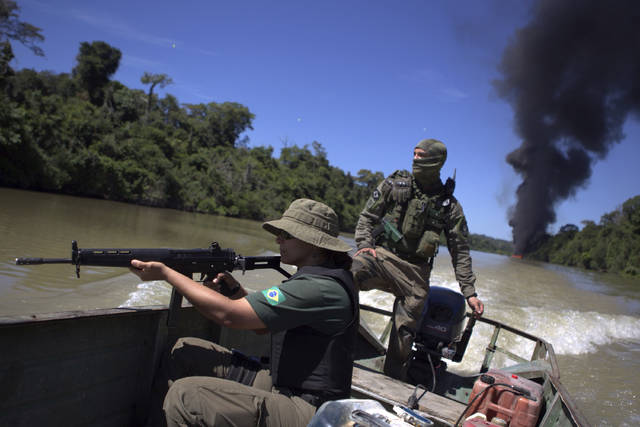
In this June 24, 2017 photo released by Ibama, the Brazilian Environmental and Renewable Natural Resources Institute, agents from the institute navigate the Novo River where they set fire to a structure that was being used by people mining illegally, behind, as they work to combat mining and deforestation in Jamanxim National Forest in Para state in Brazil’s Amazon basin. Jair Bolsonaro, who takes office January 1, claims a mandate to convert land for cattle pastures and soybean farms, calling Brazil’s rainforest protections an economic obstacle. (Felipe Werneck/Ibama via AP)
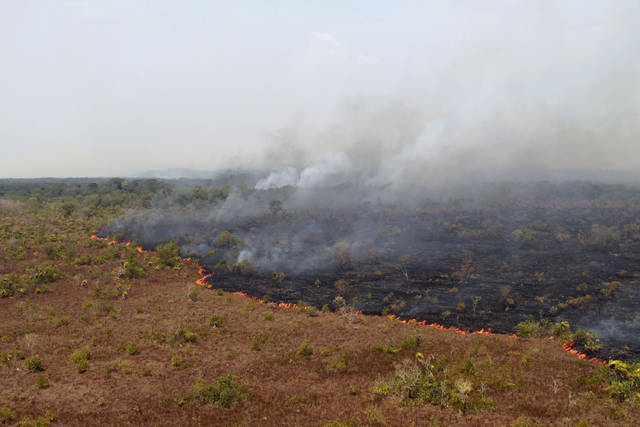
In this Aug. 25, 2016 photo released by Ibama, the Brazilian Environmental and Renewable Natural Resources Institute, a forest fire burns in Xingu Indigenous Park in Mato Grosso in Brazil’s Amazon basin. The “tipping point for the Amazon system” is 20 to 25 percent deforestation, according to Carlos Nobre and Thomas Lovejoy, environmental scientists at George Mason University. If a quarter of the rainforest is cut down, they believe there won’t be enough trees to sustain the rainfall, and a more pronounced dry season could turn more than half the rainforest into a tropical savannah. (Vinicius Mendonca/Ibama via AP)
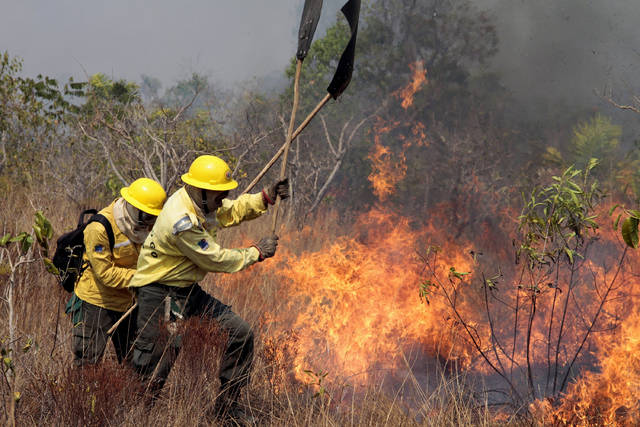
In this Aug. 25, 2016 photo released by Ibama, the Brazilian Environmental and Renewable Natural Resources Institute, members of the National Center to Prevent and Combat Forest Fires (PREVFOGO), fight a forest fire in the Xingu Indigenous Park in Mato Grosso state in Brazil’s Amazon basin. If the rainfall cycle collapses, winter droughts in parts of Brazil, Uruguay, Paraguay, and Argentina could devastate agriculture, and the impacts may be felt as far away as the American Midwest. (Vinicius Mendonca/Ibama)
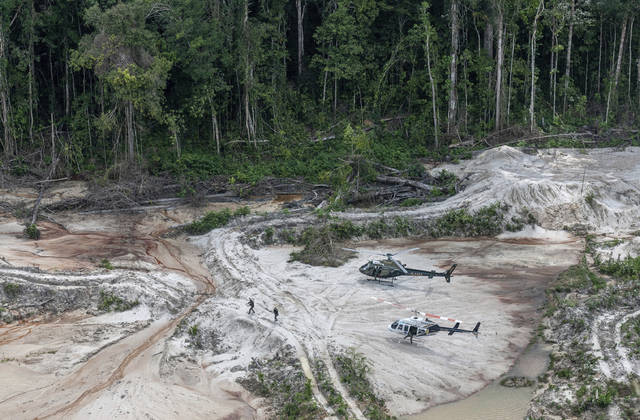
In this May 4, 2018 photo released by Ibama, the Brazilian Environmental and Renewable Natural Resources Institute, members of a specialized inspection group of Ibama walk with their weapons up through an area affected by illegal mining, after landing in helicopters in Munduruku indigenous lands in Para state in Brazil’s Amazon basin. On the campaign trail, President-elect Jair Bolsonaro promised to loosen protections for areas of the Brazilian Amazon designated as indigenous lands and nature reserves, calling them impediments to economic growth. (Vinicius Mendonca/Ibama via AP)
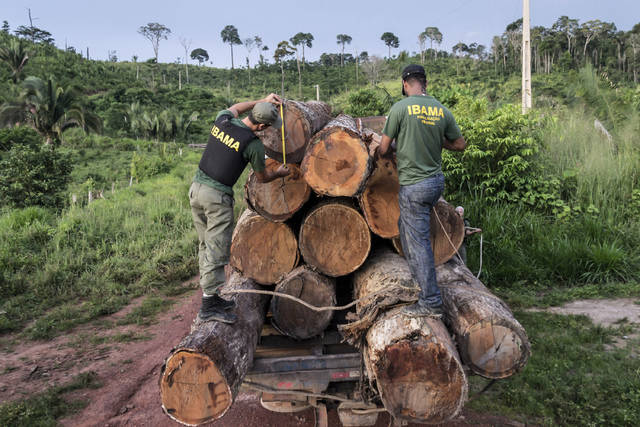
In this March 10, 2018 photo released by Ibama, the Brazilian Environmental and Renewable Natural Resources Institute, agents from Ibama measure illegally cut timber from Cachoeira Seca indigenous land in Para state in Brazil’s Amazon basin. The Amazon takes in as much as 2 billion tons of carbon dioxide a year and releases 20 percent of the planet’s oxygen, earning it the nickname “the lungs of the planet.” (Vinicius Mendonza/Ibama via AP)
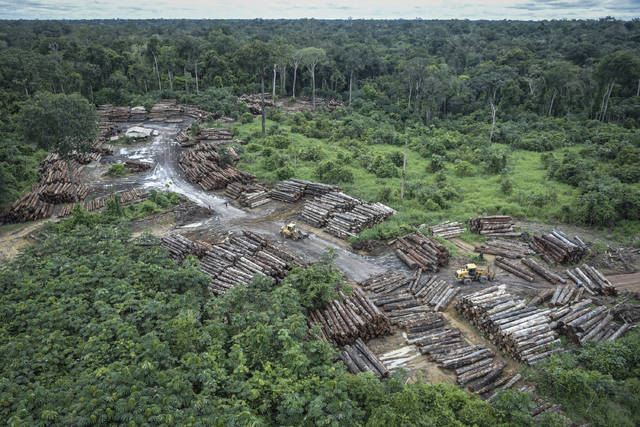
This May 8, 2018 photo released by the Brazilian Environmental and Renewable Natural Resources Institute (Ibama) shows an illegally deforested area on Pirititi indigenous lands as Ibama agents inspect Roraima state in Brazil’s Amazon basin. Scientists warn that Brazil’s President-elect Jair Bolsonaro could push the Amazon rainforest past its tipping point by loosening environmental protections, with severe consequences for global climate and rainfall. (Felipe Werneck/Ibama via AP)
SAO PAULO — Scientists warn that Brazil’s president-elect could push the Amazon rainforest past its tipping point — with severe consequences for global climate and rainfall.
SAO PAULO — Scientists warn that Brazil’s president-elect could push the Amazon rainforest past its tipping point — with severe consequences for global climate and rainfall.
Jair Bolsonaro, who takes office Jan. 1, claims a mandate to convert land for cattle pastures and soybean farms, calling Brazil’s rainforest protections an economic obstacle.
Brazil contains about 60 percent of the Amazon rainforest, and scientists are worried.
It’s nearly impossible to overstate the importance of the Amazon rainforest to the planet’s living systems, said Carlos Nobre, a climate scientist at the University of Sao Paulo.
Each tree stores carbon absorbed from the atmosphere. The Amazon takes in as much as 2 billion tons of carbon dioxide a year and releases 20 percent of the planet’s oxygen, earning it the nickname “the lungs of the planet.”
It’s also a global weather-maker.
Stretching 10 times the size of Texas, the Amazon is the world’s largest rainforest. Billions of trees suck up water through deep roots and bring it up to their leaves, which release water vapor that forms a thick mist over the rainforest canopy.
This mist ascends into clouds and eventually becomes rainfall — a cycle that shapes seasons in South America and far beyond.
By one estimate, the Amazon creates 30 to 50 percent of its own rainfall.
Now the integrity of all of three functions — as a carbon sink, the Earth’s lungs, and a rainmaker — hangs in the balance.
On Oct. 28, Brazilians elected Bolsonaro, a far-right candidate who channeled outrage at the corruption scandals of the former government and support from agribusiness groups. His election came weeks before an international summit in December where leaders will discuss how to curb climate change.
On the campaign trail, Bolsonaro promised to loosen protections for areas of the Brazilian Amazon designated as indigenous lands and nature reserves, calling them impediments to economic growth. “All these reserves cause problems to development,” he told supporters.
He has also repeatedly talked about gutting the power of the environmental ministry to enforce existing green laws.
“If Bolsonaro keeps his campaign promises, deforestation of the Amazon will probably increase quickly — and the effects will be felt everywhere on the planet,” said Paulo Artaxo, a professor of environmental physics at the University of Sao Paulo.
Bolsonaro’s transition team did not respond to an interview request from the Associated Press.
Brazil was once seen as a global environmental success story. Between 2004 and 2014, stricter enforcement of laws to safeguard the rainforest — aided by regular satellite monitoring and protections for lands designated reserves for indigenous peoples — sharply curbed the rate of deforestation, which peaked in the early 2000s at about 9,650 square miles a year (25,000 square kilometers).
After a political crisis engulfed Brazil, leading to the 2016 impeachment of president Dilma Rousseff, enforcement faltered. Ranchers and farmers began to convert more rainforest to pastureland and cropland. Between 2014 and 2017, annual deforestation doubled to about 3,090 square miles (8,000 square kilometers). Most often, the trees and underbrush cut down are simply burned, directly releasing carbon dioxide, said Artaxo.
“In the Brazilian Amazon, far and away the largest source of deforestation is industrial agriculture and cattle ranching,” said Emilio Bruna, an ecologist at the University of Florida in Gainesville.
Now observers are parsing Bolsonaro’s campaign statements and positions as a congressman to anticipate what’s next for the Amazon.
Bolsonaro — who some call “tropical Trump” because of some similarities to U.S. President Donald Trump — is a former army captain with a knack for channeling outrage and generating headlines. As a federal congressman for 27 years, he led legislative campaigns to unravel land protections for indigenous people and to promote agribusiness. He also made derogatory comments about minorities, women, and LGBT people.
Much of his support comes from business and farming interests.
“These farmers are not invaders, they are producers,” said congressman and senator-elect Luiz Carlos Heinze, a farmer and close ally of Bolsonaro. He blamed past “leftist administrations” for promoting indigenous rights at the expense of farmers and ranchers.
“Brazil will be the biggest farming nation on Earth during Bolsonaro’s years,” said Heinze.
Indigenous-rights advocates are worried about the new direction signaled. “Bolsonaro has repeatedly said that indigenous territories in the Amazon should be opened up for mining and agribusiness, which goes completely in the opposite direction of our Constitution,” said Adriana Ramos, public policy coordinator at Social Environmental Institute in Brasilia, a non-governmental group.
In a Nov. 1 post-election interview with Catholic TV, Bolsonaro said, “We intend to protect the environment, but without creating difficulties for our progress.”
Bolsonaro has repeatedly said that Brazil should withdraw from the Paris Climate Accord, a treaty his predecessor signed in 2016 committing to reduce carbon emissions 37 percent over 2005 levels by 2030. After the election, he has publicly wavered.
Meanwhile he has named a climate-change denier, Ernesto Araujo, to become the next foreign minister.
Nelson Ananias Filho, sustainability coordinator at Brazil’s National Agriculture and Cattle Raising Confederation, which backed Bolsonaro’s campaign, said, “Brazil’s agribusiness will adapt to whatever circumstances come.”
Whether or not Brazil formally remains in the Paris Climate Accord, the only way for the country to make its emission targets is to completely stop deforestation by 2030 and to reduce agricultural emissions, said Nobre, the climate scientist. “If Bolsonaro keeps moving in the current direction, that’s basically impossible.”
There’s another danger lurking in deforestation.
Aside from the oceans, tropical forests are the most important regions on the planet for putting water vapor in the air, which eventually becomes rainfall. “It’s why we have rain in the American Midwest and other inland areas — it’s not just the Amazon, but it’s the largest tropical rainforest,” said Bill Laurance, a tropical ecologist at James Cook University in Cairns, Australia.
Carlos Nobre and Thomas Lovejoy, an environmental scientist at George Mason University, have estimated that the “tipping point for the Amazon system” is 20 to 25 percent deforestation.
Without enough trees to sustain the rainfall, the longer and more pronounced dry season could turn more than half the rainforest into a tropical savannah, they wrote in February in the journal Science Advances.
If the rainfall cycle collapses, winter droughts in parts of Brazil, Uruguay, Paraguay, and Argentina could devastate agriculture, they wrote. The impacts may even be felt as far away as the American Midwest, said Laurance.
Bolsonaro’s rhetoric about potentially dismantling the environmental ministry and rolling back indigenous rights worries Nobre who says, “I am a scientist, but I am also a Brazilian citizen, and a citizen of the planet.”
———
AP Health and Science writer Christina Larson reported from Washington, D.C.
———
The Associated Press Health & Science Department receives support from the Howard Hughes Medical Institute’s Department of Science Education. The AP is solely responsible for all content.


Right wing politics do not see the benefits of rain forests, but only the green backs of the $$$$$$.